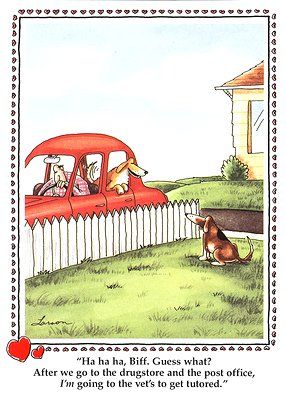Myths and facts about
Spaying and Neutering MYTH: My pet will get fat and lazy.
MYTH: My pet will get fat and lazy.
FACT: The truth is that most pets get fat and lazy because their owners feed them too much and don’t give them enough exercise.
MYTH: It’s better to have one litter first.
FACT: Medical evidence indicates just the opposite. In fact, the evidence shows that females spayed before their first heat are typically healthier. Many veterinarians now sterilize dogs and cats as young as eight weeks of age. Check with your veterinarian about the appropriate time for these procedures.
MYTH: My children should experience the miracle of birth.
FACT: Even if children are able to see a pet give birthwhich is unlikely, since it usually occurs at night and in seclusionthe lesson they will really learn is that animals can be created and discarded as it suits adults. Instead, it should be explained to children that the real miracle is life and that preventing the birth of some pets can save the lives of others.
MYTH: But my pet is a purebred.
FACT: So is at least one out of every four pets brought to animal shelters around the country. There are just too many dogs and catsmixed breed and purebred.
MYTH: I want my dog to be protective.
FACT: Spaying or neutering does not affect a dog’s natural instinct to protect home and family. A dog’s personality is formed more by genetics and environment than by sex hormones.
MYTH: I don’t want my male dog or cat to feel like less of a male.
FACT: Pets don’t have any concept of sexual identity or ego. Neutering will not change a pet’s basic personality. He doesn’t suffer any kind of emotional reaction or identity crisis when neutered.
MYTH: But my dog (or cat) is so special, I want a puppy (or kitten) just like her.
FACT: A dog or cat may be a great pet, but that doesn’t mean her offspring will be a carbon copy. Professional animal breeders who follow generations of bloodlines can’t guarantee they will get just what they want out of a particular litter. A pet owner’s chances are even slimmer. In fact, an entire litter of puppies or kittens might receive all of a pet’s (and her mate’s) worst characteristics.
MYTH: It’s too expensive to have my pet spayed or neutered.
FACT: The cost of spaying or neutering depends on the sex, size, and age of the pet, your veterinarian’s fees, and a number of other variables. But whatever the actual price, spay or neuter surgery is a one-time costa relatively small cost when compared to all the benefits. It’s a bargain compared to the cost of having a litter and ensuring the health of the mother and litter; two months of pregnancy and another two months until the litter is weaned can add up to significant veterinary bills and food costs if complications develop. Most importantly, it’s a very small price to pay for the health of your pet and the prevention of the births of more unwanted pets.
MYTH: I’ll find good homes for all the puppies and kittens.
FACT: You may find homes for all of your pet’s litter. But each home you find means one less home for the dogs and cats in shelters who need good homes. Also, in less than one year’s time, each of your pet’s offspring may have his or her own litter, adding even more animals to the population. The problem of pet overpopulation is created and perpetuated one litter at a time.
Why You Should Spay or Neuter Your Pet
Source: Humane Society of the United States
Besides the obvious reason to spay and neuter, to control the over-population problem of companion animals, we have provided some other benefits outlined below. Over 5 million dogs and cats are euthanized every year in animal shelters across the U.S. This does not include the millions more that die on the streets from traffic accidents, starvation, disease, etc.
What do “Spay” and “Neuter” really mean?
Female dogs and cats are spayed by removing their reproductive organs, and male dogs and cats are neutered by removing their testicles. In both cases the operation is performed while the pet is under anesthesia. Depending on your pet’s age, size, and health, he or she will stay at your veterinarian’s office for a few hours or a few days. Depending upon the procedure, your pet may need stitches removed after a few days. Your veterinarian can fully explain spay and neuter procedures to you and discuss with you the best age at which to sterilize your pet.
Spaying or Neutering Is Good for Your Pet
-
Spaying and neutering helps dogs and cats live longer, healthier lives.
-
Spaying and neutering can eliminate or reduce the incidence of a number of health problems that can be very difficult or expensive to treat.
-
Spaying eliminates the possibility of uterine or ovarian cancer and greatly reduces the incidence of breast cancer, particularly when your pet is spayed before her first estrous cycle.
-
Neutering eliminates testicular cancer and decreases the incidence of prostate disease.
Spaying or Neutering Is Good for You
- Spaying and neutering makes pets better, more affectionate companions.
- Neutering cats makes them less likely to spray and mark territory.
- Spaying a dog or cat eliminates her heat cycle. Estrus lasts an average of six to 12 days, often twice a year, in dogs and an average of six to seven days, three or more times a year, in cats. Females in heat can cry incessantly, show nervous behavior, and attract unwanted male animals.
- Unsterilized animals often exhibit more behavior and temperament problems than do those who have been spayed or neutered.
- Spaying and neutering can make pets less likely to bite.
- Neutering makes pets less likely to roam the neighborhood, run away, or get into fights.
Spaying and Neutering Are Good for the Community
- Communities spend millions of dollars to control unwanted animals.
- Irresponsible breeding contributes to the problem of dog bites and attacks.
- Animal shelters are overburdened with surplus animals.
- Stray pets and homeless animals get into trash containers, defecate in public areas or on private lawns, and frighten or anger people who have no understanding of their misery or needs.
- Some stray animals also scare away or kill birds and wildlife

Phone & Email
PH: (please email us)
gardkm@gmail.com
Hours
By Appointment Only
Address
100 Dichroic Dragon Dr.
Pembroke, GA 31321
Take I-16 to Exit 137 (Hwy. 119). Go south towards Pembroke, GA. We are 2.3 miles on the left.
